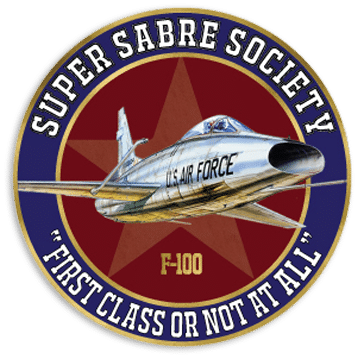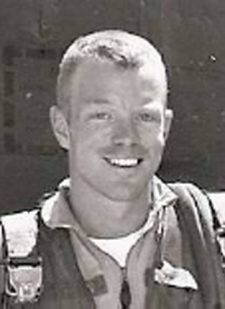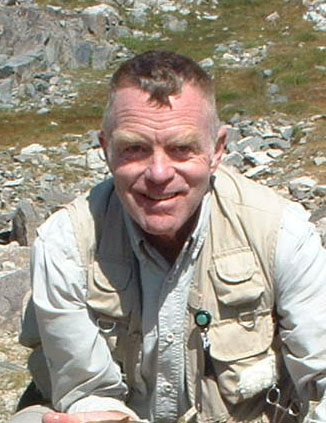From a Hero to a Bum
“In March 1969, one of my squadron mates and I were returning to Phan Rang from a mission in III Corps and had not expended our 20mm. On a whim, we checked in with a local FAC to see if he had any use for our bullets. As usual, he had a dangerous enemy hooch nestled in a valley about 10 miles from home and asked if we would like to shoot it up. Silly question.
My buddy rolled in first and fired a nice burst into the hooch. I followed, diving right into the base of the valley with mountains rising in the background. When I finally decided to pull up, “up” was a long way up. If I was going to miss the mountain, I would need all the G’s available and would have to climb at a pretty good rate. So I pulled right up to the point of stalling, and sailed out of there, just barely. In fact, I thought I heard a little “thunk” as I went by the ridgeline.
The FAC was watching the show, of course, and quickly yelled, “Hey, Two, did you hit those trees?” Naturally, I said I didn’t think so. But then I looked in the rearview mirror and was surprised to see ½ of the left slab gone and a couple of dents in the right. (Paradoxically, there was just over 6.0 Gs on the G-meter, and I have often wondered if I had pulled just a little harder, would I have missed the trees altogether, or mushed into them with fatal results. I like to think I had a sense of the max performance possible, and got all the climb I could out of the aircraft.)
Thinking to myself that this was going to be hard to hide, I called Lead over to check out the damage. He let out a low whistle and proceeded to describe holes in the left flap, holes in the fuselage, a mashed and mangled left drop tank, major slab damage, and other miscellaneous scratches.
I headed for home and did a controllability check. From the cockpit, I could not feel any degraded flight characteristics, and the engine was fine. So I left the gear down, flew on over to Phan Rang, and landed. The Wing King was clearly not happy about my messing up his F-100, not to mention that I had almost killed myself for a hooch that had been plastered 1,000 times before, so he grounded me on the spot.
Now, I am not particularly proud of the foregoing, but I do know that all F-100 drivers in SEA either hit the trees or almost did. One of the peculiarities of our flying out of Phan Rang at that point in the war was that 90% of our targets were in III Corps, and most of the rest were in the Delta. As a result, we had very little experience in mountain flying.
The story goes on. “Gunsmoke One” opened each Wing meeting with an Awards Ceremony. [I was called] to the podium to educate the boys on how to strafe in the mountains. I had a pretty good presentation, too, having spoken to some smart jocks from Tuy Hua and Phu Cat to pick their brains on successful mountain-strafing techniques. I started my remarks with the observation that, “It doesn’t take long to go from a hero to a bum around here.” Even Gunsmoke One, Col. Frank Gailer, had to smile a little.
But the story does not end there. I left Phan Rang in July and got a Consecutive Overseas Tour (COT) to Lakenheath. A few months later, guess who showed up at the Heath as our new wing commander—of course, Frank Gailer! The first thing I heard after he took over was a call from my squadron commander that the new wing commander wanted me to report to his office ASAP. I presumed he wanted to tell me what an honor it was for him to have me in his wing.
I reported in with a snappy salute. He looked at me for a long minute and then reached into the top right drawer of his desk and pulled out a small piece of wood. It was a mangled palm tree branch about the size of your middle finger. “Do you know what this is?” he asked. I answered that I thought I did. “Good!” he said, “Don’t forget it! Dismissed.” As I closed his office door behind me, I could hear him chuckling under his breath.
This is a story about dumb flying, but it is also a story about good leadership. Frank Gailer had many ways he could have handled my tree busting act, up to and including taking my wings. But he saw possibilities in a young first lieutenant and decided to gamble on a second chance. …I saw him from time to time after he retired, and he always regaled whoever was within shouting distance with a story, at my expense, accompanied by raucous laughter, of how easy it was to go from a “hero to a bum.””(For the full story see Issue 23 of The Intake.)
Maj. Gen. Francis C. Gideon Jr.was the chief of safety of the U.S. Air Force, and commander, Headquarters Air Force Safety Center, Kirtland Air Force Base, NM He served as the senior uniformed adviser to the chief of staff and the secretary of the Air Force on all issues involving the safety of a combined active duty, Guard, Reserve and civilian force of more than 700,000 people serving approximately 2,300 locations in the United States and overseas.
His career touched many aspects of the Air Force mission as a fighter pilot, an experimental test pilot, and in acquisition, intelligence and logistics. His assignments spanned the globe from Thailand to England. He commanded one of the Air Force’s three test wings and its center for scientific and technical intelligence. He is a command pilot with almost 3,000 hours flying in 30 kinds of aircraft. He was an A-10 test pilot and flew 220 combat missions in Southeast Asia in F-100s and F-4s.
Rusty Gideon retired from the USAF on July 1, 2000.
(source: The Intake and US Airforce)
Then, everything went black! – Major Francis C. Gideon Ejection Story
The purpose of an ejection seat in aircraft is that it gives the pilot a chance of survival if things should go wrong. Not only did things go badly wrong with the aircraft on Thursday 8th June 1978 but at some point in his egress from the plane and landing by parachute 34-year-old Major Gideon sustained a broken neck.
Francis Gideon was a test pilot on the A-10 Joint Test Force at the Air Force Flight Test Center, Edwards Air Force Base, California.
The Air Force was in the final phase of qualifying a new manufacturer of bullets for the GAU-8 Gatling gun. The test held that day called for five gun-firing passes of 100 rounds each. On the fourth pass, things began to go wrong.
Maj. Gen. Gideon remembers:
“I pulled the trigger, felt the gun firing, saw the gun gas cloud form, and then saw it burst into flame.”
A large ball of fire standing on the nose of the aircraft had resulted due to“secondary gun gas ignition”, and it would remain as long as the bullets were firing. The fire was starving the natural oxygen supply necessary for the engines to function.
“In effect, the engines were burning up and no thrust was being produced. There is a remedy for this situation—quickly shut down the engines before damage is done, cool them off, and then restart. Obviously, during this procedure, the aircraft has become a glider and in the case of the A-10, it comes down pretty fast.”
Major Gideon immediately released the trigger and pulled up to terminate the mission, then shut off the overheating engines, pulled up further to attain the best glide speed, and made a radio transmission to the chase pilot about what was happening.
2000 feet above the terrain without good engines
For two minutes Gideon watched the temperature gauges slowly creep down, but all the while the A-10 was losing altitude. “Eventually, though the temperature was still a bit high, I could not stand it anymore, and began the start sequence on the left engine, realizing that it would take about 45 seconds to attain full power. And it would take full power to fly out of there with a heavy A-10 on one engine. At almost the same moment, I estimated I was descending through 2000 feet above the terrain. There was also a ridge line ahead that I was not sure I would clear.
Air Force training says that the pilot should leave an in-control, but doomed jet at or above 2000 feet. That figure was chosen to give the ejection equipment plenty of time to function. It also gives the pilot a little time to handle a minor malfunction such as the seat belt, not opening, or a parachute problem. Since I was unsure whether the engine would start, would actually deliver full power, and whether I was still going to be above the ground in 45 seconds, I made the easy decision to eject. I called the chase pilot and told him I was on the way out. He said “fine”, and immediately made a “Mayday” call to start rescue operations. His photographer was also ready to film the ejection, which turned out to be a great help in the subsequent mishap investigation. Thinking ahead, by the way, the chase pilot had moved around to the right side of the A-10 to get the best sun angle for the photography.
Ejection
Major Gideon pulled the handle that activated the ejection sequence. In under 2 seconds, he was swinging below his parachute. In textbook ejections, pilots are intended to have their aircraft in full control, slow airspeed, and prepare themselves in the optimum position to avoid injury. Head pressed against the back of the seat, spine aligned with the direction of thrust. Ejection from a fighter aircraft is, however, a violent event. In that 1.85 seconds from pulling the handle, the canopy is blown off, then a ballistic charge propels the seat and occupant, guided by rails, upwards and out of the aircraft. Then the seat automatically separated the pilot and puts him on the end of a parachute. After a time-dependent upon the height at which the parachute deployed, the pilot adopts a landing posture to avoid injury on reaching the ground.

Major Gideon’s experience, as the film of the event was to show, was not a textbook ejection. His head was yanked forward by the G-forces at ejection putting a severe strain on his neck, further strain was applied to the neck as the Major’s body decelerated rapidly with the opening shock of the parachute, and unable to get into a suitable landing stance he hit the ground hard, “heels, butt, and head” further jarring the already injured neck. On landing, the Major’s head and neck suffered more trauma when his helmet hit the “only rock within 50 yards and taking a chip out of the helmet.”
“The only choices I could think of were that I was in the chute, I was plummeting toward the ground, or I was in Heaven. I put my hands up to my face, and then I could see again. Looking up, I found myself happily hanging under the chute. I felt very good at that point because I had been there before. One other aspect of my prior military training was to attend the Army’s Parachute Training School when I was an Air Force Academy cadet years before. Even though my neck was in pain, I felt safe and secure again, glad to be hanging under that parachute. I also said a quiet thank you to the gent who took care of my ejection equipment. The reason I could not see? I think my helmet had rotated forward on my head and down across my eyes!”
Major Gideon was not yet aware of the severity of his injuries…
“I got up, silenced the emergency beacon, and contacted the chase pilot via radio. When I told him I was okay but my neck hurt, he wisely advised me to lie still and await rescue. I flipped over the one-man life raft which automatically inflates from the seat kit during the ejection sequence (one of the other necessary miracles), and used it for a bed until a helicopter arrived with rescue personnel. They were there within 25 minutes to transport me back to the base hospital.” Francis Gideon’s neck was in fact broken.“I was treated at the local Palmdale, CA, hospital which had an outstanding neurosurgeon, and was back flying the A-10 again in exactly six months.”
“I have always felt that the major injury occurred at the time the rocket fired. When I was hanging in the chute, my neck already was hurting significantly. After hitting the ground and snapping my neck again, it still felt the same. But the mishap board ruled that the break occurred on landing. The reasoning was that if my neck had been broken before then, it would have been unstable, and the blow from the landing would have killed me. It is hard to argue with that logic.”
Major General Gideon is candid about the lessons learned from the mishap.
“One of the major findings from the investigation was that we had not done our homework very well in planning the mission. That is, we failed to recognize some of the potential hazards connected with the gunfire. We were lulled into a false sense of safety since all three batches of ammunition had been fired numerous times on development firing ranges on the ground. They had performed flawlessly there. In addition, though there had been a few instances of SGGI before, in all those cases only one engine at a time had been affected. SGGI had also been a big worry early in the developmental testing of the A-10, but none of us at the Joint Test Force in 1978 were personally involved back then. Also, engineers at the Program Office who were familiar with the earlier testing did not speak up forcefully about possible dangers.”
Major changes in test procedures at Edwards AFB were made because of this mishap and proved to be extremely effective in preventing further mishaps and are still in place at the Flight Test Center. Another major result of the mishap was the speeding up of the fitting of the ACES II to the A-10s.
A small silver lining
In conclusion Francis Gideon again, “Aircraft mishaps are not desirable and are usually preventable. But when they do occur, a good investigation will find the underlying causes. The subsequent recommendations, if followed, will prevent future mishaps of the same kind. There can be a small silver lining in an aircraft mishap, and I believe there was with this one.”
Source: (Photo source: :Https://www.torch.aetc.af.mil/News/Features/Display/Article/365447/even-though-he-had-to-eject-from-one-of-the-first-a-10-attack-aircraft-this-for/)









